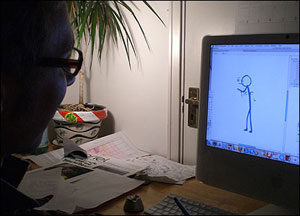Animator
Tasks & duties

Animators may do some or all of the following:
-
meet with directors, clients or employers to discuss their animation requirements
-
agree on a brief (work plan) with the client or employer
-
animate characters in 2-D or 3-D
-
create 3-D mesh wireframes to produce backdrops for 2-D and 3-D animation scenes
-
build models, puppets or sets
-
hand-draw or paint characters and give the characters a skin surface, adding texture and colour
-
place the image into an animation computer program and frame each drawing to create the animation
-
program special effects such as colour fading and reflection
-
film models, puppets, sets or hand-drawn animations
-
refine the animation based on feedback from the director, client or employer
Specialisations
Stop-motion or Claymation Animator
Stop-motion or claymation animators build models or puppets and move them for each frame, which is photographed or digitised. These frames are put together to create the illusion of movement.
3-D Animator
3-D animators design images and use a computer to build models that give the images three-dimensional texture, depth and motion.
2-D Animator
2-D animators create moving pictures through cel animation (traditional drawn animation) or by using computerised animation software. They sequence consecutive images in frames to create motion which appears as a moving image (cartoon animation).
Motion Graphics Animator
Motion graphics animators prepare graphics for film or television by scanning images and working with colour, visual effects, graphics and topography on a computer.
Cel Animator
Cel animators hand-draw each image or frame of a cartoon.
Skills & knowledge

Animators need to have:
-
drawing, painting and design skills
-
knowledge of drawing and animation techniques
-
knowledge of the different styles of animation such as 2-D and 3-D
-
an understanding of design and layout
-
an understanding of how people and animals move and express their feelings
-
the ability to create different moods and feelings in characters
-
familiarity with the history of art and design
-
knowledge of film and television production
-
good communication skills
Animators specialising in computer animation need to be highly skilled in at least one animation software program.
Entry requirements
To become an animator you need to have experience in your specialist area. You also need a portfolio of work or showreel with a shot list describing what you did in each shot. Some employers may require you to have previous experience with particular animation software.
A Bachelor of Design, majoring in visual communication design, or a Diploma in Character Animation is often preferred by employers.
Secondary education
At least four years of secondary education and a portfolio of work is needed to enter a tertiary design programme. Useful subjects include computer studies, graphics, art, biology and woodwork.
Tertiary education
Many animators have a Bachelor of Design majoring in animation or visual communication. Other useful university subjects include fine art, illustration and graphic design.
Training on the job
Although the basics of animation are learned through training institutes, animators need to keep up to date with new techniques and computer software in their specialty area. One way of doing this is by studying what other animators are doing, through reading their blogs and websites, or subscribing to magazines with the latest styles and industry news.
Useful experience
Useful experience for animators includes:
-
drawing, life drawing, cartooning or graphic design experience
-
experience in film, amateur dramatics or photography
-
computer design and drawing experience
-
experience with animation software
Related courses
Fine Arts
Graphic Arts and Design Studies
For more information, please refer to Career Services.
Document Actions
